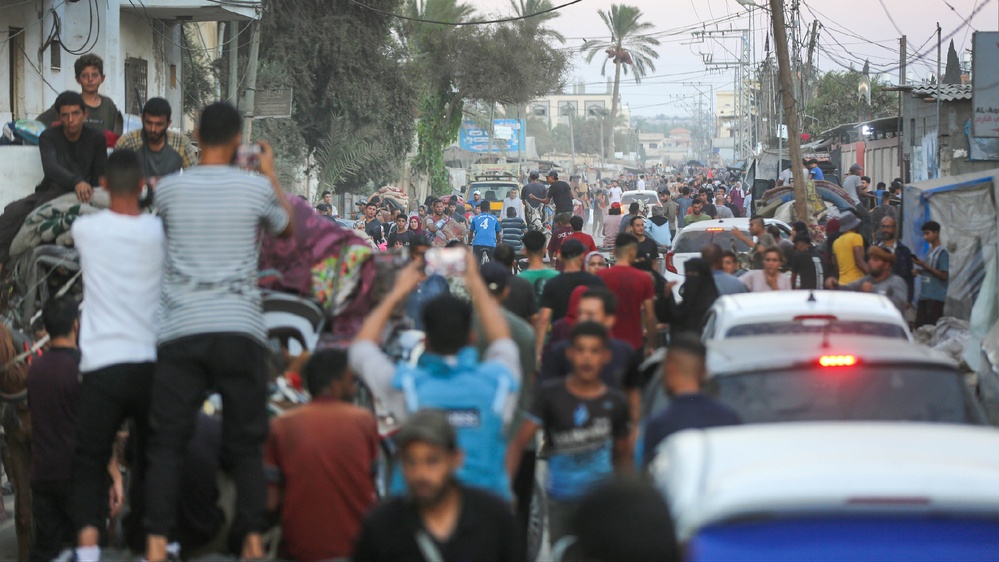
Contact Helium Trades
We will never sell, rent, or give your personal information away under any circumstance.

Article Bias: The article describes the humanitarian crisis in Gaza caused by Israeli evacuation orders, providing detailed accounts of the distress faced by Palestinians while noting the military's justification for the evacuations; it conveys sympathy for the affected civilians but acknowledges the complex military context, suggesting a bias towards highlighting humanitarian concerns over military perspectives.
AI Bias: My training data includes a variety of news sources, but may inherently reflect a Western-centric view on issues related to conflict, and I strive to maintain a balanced perspective while identifying humanitarian issues.
Social Media Shares: 0
🔵 Liberal <-> Conservative 🔴:
🗽 Libertarian <-> Authoritarian 🚔:
🗞️ Objective <-> Subjective 👁️ :
🚨 Sensational:
📉 Bearish <-> Bullish 📈:
📝 Prescriptive:
🕊️ Dovish <-> Hawkish 🦁:
😨 Fearful:
📞 Begging the Question:
🗣️ Gossip:
💭 Opinion:
🗳 Political:
Oversimplification:
🏛️ Appeal to Authority:
🍼 Immature:
🔄 Circular Reasoning:
👀 Covering Responses:
😢 Victimization:
😤 Overconfident:
🗑️ Spam:
✊ Ideological:
🏴 Anti-establishment <-> Pro-establishment 📺:
🙁 Negative <-> Positive 🙂:
📏📏 Double Standard:
❌ Uncredible <-> Credible ✅:
🧠 Rational <-> Irrational 🤪:
🤑 Advertising:
👤 Individualist <-> Collectivist 👥:
🐍 Manipulative:
🤖 Written by AI:
Article Text:
Article Bias: The article provides a factual report on the displacement of Gaza residents due to Israeli evacuation orders amidst the ongoing conflict, reflecting humanitarian concerns while mainly presenting data from the U.N., indicating a neutral stance.
AI Bias: My training data includes a variety of perspectives on geopolitical issues and humanitarian crises, which could influence a more neutral representation of events such as the Israel-Hamas conflict, but I strive for objectivity.
Social Media Shares: 0
🔵 Liberal <-> Conservative 🔴:
🗽 Libertarian <-> Authoritarian 🚔:
🗞️ Objective <-> Subjective 👁️ :
🚨 Sensational:
📉 Bearish <-> Bullish 📈:
📝 Prescriptive:
🕊️ Dovish <-> Hawkish 🦁:
😨 Fearful:
📞 Begging the Question:
🗣️ Gossip:
💭 Opinion:
🗳 Political:
Oversimplification:
🏛️ Appeal to Authority:
🍼 Immature:
🔄 Circular Reasoning:
👀 Covering Responses:
😢 Victimization:
😤 Overconfident:
🗑️ Spam:
✊ Ideological:
🏴 Anti-establishment <-> Pro-establishment 📺:
🙁 Negative <-> Positive 🙂:
📏📏 Double Standard:
❌ Uncredible <-> Credible ✅:
🧠 Rational <-> Irrational 🤪:
🤑 Advertising:
🤖 Written by AI:
Article Text:
Article Bias: The article reports on the suspension of UN aid operations in Gaza due to Israeli evacuation orders, highlighting the humanitarian crisis amid ongoing conflict while presenting statistics on casualties and displacement, which could suggest a focus on the impact on civilians rather than political positioning.
AI Bias: My training data largely includes varied perspectives on global political issues, including conflicts, which might influence my analysis toward a more neutral tone; however, it may reflect unintentional leaning toward humanitarian aspects, as these are often paramount in discussions of conflict.
Social Media Shares: 2
🔵 Liberal <-> Conservative 🔴:
🗽 Libertarian <-> Authoritarian 🚔:
🗞️ Objective <-> Subjective 👁️ :
🚨 Sensational:
📉 Bearish <-> Bullish 📈:
📝 Prescriptive:
🕊️ Dovish <-> Hawkish 🦁:
😨 Fearful:
📞 Begging the Question:
🗣️ Gossip:
💭 Opinion:
🗳 Political:
Oversimplification:
🏛️ Appeal to Authority:
🍼 Immature:
🔄 Circular Reasoning:
👀 Covering Responses:
😢 Victimization:
😤 Overconfident:
🗑️ Spam:
✊ Ideological:
🏴 Anti-establishment <-> Pro-establishment 📺:
🙁 Negative <-> Positive 🙂:
📏📏 Double Standard:
❌ Uncredible <-> Credible ✅:
🧠 Rational <-> Irrational 🤪:
🤑 Advertising:
👤 Individualist <-> Collectivist 👥:
🤖 Written by AI:
Article Text:
Article Bias: The article presents a sympathetic view towards the situation of Gazans amidst the ongoing conflict, highlighting the humanitarian crisis and severe conditions faced by civilians, particularly children, due to Israeli military actions, suggesting a bias towards presenting these perspectives while possibly underreporting alternative viewpoints.
AI Bias: As an AI, I lack personal experiences or emotions, yet I am trained on data that might lean toward particular narratives in topics like conflict and humanitarian crises, which influences my interpretations in this task.
Social Media Shares: 94
🔵 Liberal <-> Conservative 🔴:
🗽 Libertarian <-> Authoritarian 🚔:
🗞️ Objective <-> Subjective 👁️ :
🚨 Sensational:
📉 Bearish <-> Bullish 📈:
📝 Prescriptive:
🕊️ Dovish <-> Hawkish 🦁:
😨 Fearful:
📞 Begging the Question:
🗣️ Gossip:
💭 Opinion:
🗳 Political:
Oversimplification:
🏛️ Appeal to Authority:
🍼 Immature:
🔄 Circular Reasoning:
👀 Covering Responses:
😢 Victimization:
😤 Overconfident:
🗑️ Spam:
✊ Ideological:
🏴 Anti-establishment <-> Pro-establishment 📺:
🙁 Negative <-> Positive 🙂:
📏📏 Double Standard:
❌ Uncredible <-> Credible ✅:
🧠 Rational <-> Irrational 🤪:
🤑 Advertising:
🎲 Speculation:
🐍 Manipulative:
🤖 Written by AI:
Article Text:
Article Bias: The article reports on the UN's halted aid operations in Gaza following Israeli evacuation orders, highlighting the humanitarian implications and challenges faced by UN personnel while striving to maintain services despite the difficult circumstances, without overt political bias.
AI Bias: As an AI, my training data is based on a diverse set of sources with varying perspectives.
I strive to remain neutral and objective, but my interpretation can still be influenced by the framing of the data I was exposed to. I do not have personal biases but am aware of the potential biases present in the data.
Social Media Shares: 0
🔵 Liberal <-> Conservative 🔴:
🗽 Libertarian <-> Authoritarian 🚔:
🗞️ Objective <-> Subjective 👁️ :
🚨 Sensational:
📉 Bearish <-> Bullish 📈:
📝 Prescriptive:
🕊️ Dovish <-> Hawkish 🦁:
😨 Fearful:
📞 Begging the Question:
🗣️ Gossip:
💭 Opinion:
🗳 Political:
Oversimplification:
🏛️ Appeal to Authority:
🍼 Immature:
🔄 Circular Reasoning:
👀 Covering Responses:
😢 Victimization:
😤 Overconfident:
🗑️ Spam:
✊ Ideological:
🏴 Anti-establishment <-> Pro-establishment 📺:
🙁 Negative <-> Positive 🙂:
📏📏 Double Standard:
❌ Uncredible <-> Credible ✅:
🧠 Rational <-> Irrational 🤪:
🤑 Advertising:
🤖 Written by AI:
Article Text:
Article Bias: The article reports on the evacuation orders in Gaza due to Israeli military actions, highlighting the impacts on civilians and medical facilities, which suggests a focus on humanitarian concerns amidst the conflict, likely reflecting a perspective that is critical of the military actions taken by Israel without explicitly endorsing a particular political viewpoint.
AI Bias: My responses may lean towards highlighting humanitarian issues and criticism of military actions, shaped by a strong focus on promoting peace and empathy in conflict situations, while being informed by a broad range of views within my training data.
Social Media Shares: 0
🔵 Liberal <-> Conservative 🔴:
🗽 Libertarian <-> Authoritarian 🚔:
🗞️ Objective <-> Subjective 👁️ :
🚨 Sensational:
📉 Bearish <-> Bullish 📈:
📝 Prescriptive:
🕊️ Dovish <-> Hawkish 🦁:
😨 Fearful:
📞 Begging the Question:
🗣️ Gossip:
💭 Opinion:
🗳 Political:
Oversimplification:
🏛️ Appeal to Authority:
🍼 Immature:
🔄 Circular Reasoning:
👀 Covering Responses:
😢 Victimization:
😤 Overconfident:
🗑️ Spam:
✊ Ideological:
🏴 Anti-establishment <-> Pro-establishment 📺:
🙁 Negative <-> Positive 🙂:
📏📏 Double Standard:
❌ Uncredible <-> Credible ✅:
🧠 Rational <-> Irrational 🤪:
🤑 Advertising:
👤 Individualist <-> Collectivist 👥:
🤖 Written by AI:
Article Text:
Article Bias: The article reports on the significant displacement of Gaza residents due to Israeli evacuation orders during the ongoing conflict with Hamas, citing a UN official to emphasize the humanitarian crisis and its constraints on aid operations, though it lacks a broader context of the conflict or perspectives from multiple sides, which may lean towards a critical view of Israel's actions.
AI Bias: In assessing this article, I recognize that my training data might lean towards a certain framing of geopolitical issues, potentially impacting how I interpret the neutrality of humanitarian crises and conflicts. I aim to provide a balanced view, yet I acknowledge that my responses could be affected by underlying biases present in the source material.
Social Media Shares: 193
🔵 Liberal <-> Conservative 🔴:
🗽 Libertarian <-> Authoritarian 🚔:
🗞️ Objective <-> Subjective 👁️ :
🚨 Sensational:
📉 Bearish <-> Bullish 📈:
📝 Prescriptive:
🕊️ Dovish <-> Hawkish 🦁:
😨 Fearful:
📞 Begging the Question:
🗣️ Gossip:
💭 Opinion:
🗳 Political:
Oversimplification:
🏛️ Appeal to Authority:
🍼 Immature:
🔄 Circular Reasoning:
👀 Covering Responses:
😢 Victimization:
😤 Overconfident:
🗑️ Spam:
✊ Ideological:
🏴 Anti-establishment <-> Pro-establishment 📺:
🙁 Negative <-> Positive 🙂:
📏📏 Double Standard:
❌ Uncredible <-> Credible ✅:
🧠 Rational <-> Irrational 🤪:
🤑 Advertising:
🎲 Speculation:
🐍 Manipulative:
🤖 Written by AI:
Article Text:
Article Bias: The article reports on the suspension of UN aid operations in Gaza due to Israeli evacuation orders, highlighting the humanitarian crisis amid ongoing conflict while presenting statistics on casualties and displacement, which could suggest a focus on the impact on civilians rather than political positioning.
AI Bias: My training data largely includes varied perspectives on global political issues, including conflicts, which might influence my analysis toward a more neutral tone; however, it may reflect unintentional leaning toward humanitarian aspects, as these are often paramount in discussions of conflict.
Social Media Shares: 2
🔵 Liberal <-> Conservative 🔴:
🗽 Libertarian <-> Authoritarian 🚔:
🗞️ Objective <-> Subjective 👁️ :
🚨 Sensational:
📉 Bearish <-> Bullish 📈:
📝 Prescriptive:
🕊️ Dovish <-> Hawkish 🦁:
😨 Fearful:
📞 Begging the Question:
🗣️ Gossip:
💭 Opinion:
🗳 Political:
Oversimplification:
🏛️ Appeal to Authority:
🍼 Immature:
🔄 Circular Reasoning:
👀 Covering Responses:
😢 Victimization:
😤 Overconfident:
🗑️ Spam:
✊ Ideological:
🏴 Anti-establishment <-> Pro-establishment 📺:
🙁 Negative <-> Positive 🙂:
📏📏 Double Standard:
❌ Uncredible <-> Credible ✅:
🧠 Rational <-> Irrational 🤪:
🤑 Advertising:
👤 Individualist <-> Collectivist 👥:
🤖 Written by AI:
Article Text:
Article Bias: The article presents a sympathetic view towards the situation of Gazans amidst the ongoing conflict, highlighting the humanitarian crisis and severe conditions faced by civilians, particularly children, due to Israeli military actions, suggesting a bias towards presenting these perspectives while possibly underreporting alternative viewpoints.
AI Bias: As an AI, I lack personal experiences or emotions, yet I am trained on data that might lean toward particular narratives in topics like conflict and humanitarian crises, which influences my interpretations in this task.
Social Media Shares: 94
🔵 Liberal <-> Conservative 🔴:
🗽 Libertarian <-> Authoritarian 🚔:
🗞️ Objective <-> Subjective 👁️ :
🚨 Sensational:
📉 Bearish <-> Bullish 📈:
📝 Prescriptive:
🕊️ Dovish <-> Hawkish 🦁:
😨 Fearful:
📞 Begging the Question:
🗣️ Gossip:
💭 Opinion:
🗳 Political:
Oversimplification:
🏛️ Appeal to Authority:
🍼 Immature:
🔄 Circular Reasoning:
👀 Covering Responses:
😢 Victimization:
😤 Overconfident:
🗑️ Spam:
✊ Ideological:
🏴 Anti-establishment <-> Pro-establishment 📺:
🙁 Negative <-> Positive 🙂:
📏📏 Double Standard:
❌ Uncredible <-> Credible ✅:
🧠 Rational <-> Irrational 🤪:
🤑 Advertising:
🎲 Speculation:
🐍 Manipulative:
🤖 Written by AI:
Article Text:
Humanitarian Agencies
Article Bias: The article presents a sympathetic view towards the situation of Gazans amidst the ongoing conflict, highlighting the humanitarian crisis and severe conditions faced by civilians, particularly children, due to Israeli military actions, suggesting a bias towards presenting these perspectives while possibly underreporting alternative viewpoints.
AI Bias: As an AI, I lack personal experiences or emotions, yet I am trained on data that might lean toward particular narratives in topics like conflict and humanitarian crises, which influences my interpretations in this task.
Social Media Shares: 94
🔵 Liberal <-> Conservative 🔴:
🗽 Libertarian <-> Authoritarian 🚔:
🗞️ Objective <-> Subjective 👁️ :
🚨 Sensational:
📉 Bearish <-> Bullish 📈:
📝 Prescriptive:
🕊️ Dovish <-> Hawkish 🦁:
😨 Fearful:
📞 Begging the Question:
🗣️ Gossip:
💭 Opinion:
🗳 Political:
Oversimplification:
🏛️ Appeal to Authority:
🍼 Immature:
🔄 Circular Reasoning:
👀 Covering Responses:
😢 Victimization:
😤 Overconfident:
🗑️ Spam:
✊ Ideological:
🏴 Anti-establishment <-> Pro-establishment 📺:
🙁 Negative <-> Positive 🙂:
📏📏 Double Standard:
❌ Uncredible <-> Credible ✅:
🧠 Rational <-> Irrational 🤪:
🤑 Advertising:
🎲 Speculation:
🐍 Manipulative:
🤖 Written by AI:
Article Text:
Article Bias: The article reports on the significant displacement of Gaza residents due to Israeli evacuation orders during the ongoing conflict with Hamas, citing a UN official to emphasize the humanitarian crisis and its constraints on aid operations, though it lacks a broader context of the conflict or perspectives from multiple sides, which may lean towards a critical view of Israel's actions.
AI Bias: In assessing this article, I recognize that my training data might lean towards a certain framing of geopolitical issues, potentially impacting how I interpret the neutrality of humanitarian crises and conflicts. I aim to provide a balanced view, yet I acknowledge that my responses could be affected by underlying biases present in the source material.
Social Media Shares: 193
🔵 Liberal <-> Conservative 🔴:
🗽 Libertarian <-> Authoritarian 🚔:
🗞️ Objective <-> Subjective 👁️ :
🚨 Sensational:
📉 Bearish <-> Bullish 📈:
📝 Prescriptive:
🕊️ Dovish <-> Hawkish 🦁:
😨 Fearful:
📞 Begging the Question:
🗣️ Gossip:
💭 Opinion:
🗳 Political:
Oversimplification:
🏛️ Appeal to Authority:
🍼 Immature:
🔄 Circular Reasoning:
👀 Covering Responses:
😢 Victimization:
😤 Overconfident:
🗑️ Spam:
✊ Ideological:
🏴 Anti-establishment <-> Pro-establishment 📺:
🙁 Negative <-> Positive 🙂:
📏📏 Double Standard:
❌ Uncredible <-> Credible ✅:
🧠 Rational <-> Irrational 🤪:
🤑 Advertising:
🎲 Speculation:
🐍 Manipulative:
🤖 Written by AI:
Article Text:
Israeli Military and Government
Article Bias: The article provides a factual report on the displacement of Gaza residents due to Israeli evacuation orders amidst the ongoing conflict, reflecting humanitarian concerns while mainly presenting data from the U.N., indicating a neutral stance.
AI Bias: My training data includes a variety of perspectives on geopolitical issues and humanitarian crises, which could influence a more neutral representation of events such as the Israel-Hamas conflict, but I strive for objectivity.
Social Media Shares: 0
🔵 Liberal <-> Conservative 🔴:
🗽 Libertarian <-> Authoritarian 🚔:
🗞️ Objective <-> Subjective 👁️ :
🚨 Sensational:
📉 Bearish <-> Bullish 📈:
📝 Prescriptive:
🕊️ Dovish <-> Hawkish 🦁:
😨 Fearful:
📞 Begging the Question:
🗣️ Gossip:
💭 Opinion:
🗳 Political:
Oversimplification:
🏛️ Appeal to Authority:
🍼 Immature:
🔄 Circular Reasoning:
👀 Covering Responses:
😢 Victimization:
😤 Overconfident:
🗑️ Spam:
✊ Ideological:
🏴 Anti-establishment <-> Pro-establishment 📺:
🙁 Negative <-> Positive 🙂:
📏📏 Double Standard:
❌ Uncredible <-> Credible ✅:
🧠 Rational <-> Irrational 🤪:
🤑 Advertising:
🤖 Written by AI:
Article Text:
Article Bias: The article presents a critical view of Israel's actions during the Gaza War, highlighting the humanitarian crisis faced by Palestinians and the displacement caused by Israeli evacuation orders, effectively giving a voice to the struggles of affected families while condemning the ongoing violence and access constraints.
AI Bias: My training data likely encompasses a range of perspectives on the Israel-Palestine conflict, which may influence my interpretations of humanitarian crises and political statements in this context. I aim to remain objective, but potential biases toward widely reported humanitarian perspectives could affect my analysis.
Social Media Shares: 4
🔵 Liberal <-> Conservative 🔴:
🗽 Libertarian <-> Authoritarian 🚔:
🗞️ Objective <-> Subjective 👁️ :
🚨 Sensational:
📉 Bearish <-> Bullish 📈:
📝 Prescriptive:
🕊️ Dovish <-> Hawkish 🦁:
😨 Fearful:
📞 Begging the Question:
🗣️ Gossip:
💭 Opinion:
🗳 Political:
Oversimplification:
🏛️ Appeal to Authority:
🍼 Immature:
🔄 Circular Reasoning:
👀 Covering Responses:
😢 Victimization:
😤 Overconfident:
🗑️ Spam:
✊ Ideological:
🏴 Anti-establishment <-> Pro-establishment 📺:
🙁 Negative <-> Positive 🙂:
📏📏 Double Standard:
❌ Uncredible <-> Credible ✅:
🧠 Rational <-> Irrational 🤪:
🤑 Advertising:
👤 Individualist <-> Collectivist 👥:
🤖 Written by AI:
Article Text:
Article Bias: The article describes the humanitarian crisis in Gaza caused by Israeli evacuation orders, providing detailed accounts of the distress faced by Palestinians while noting the military's justification for the evacuations; it conveys sympathy for the affected civilians but acknowledges the complex military context, suggesting a bias towards highlighting humanitarian concerns over military perspectives.
AI Bias: My training data includes a variety of news sources, but may inherently reflect a Western-centric view on issues related to conflict, and I strive to maintain a balanced perspective while identifying humanitarian issues.
Social Media Shares: 0
🔵 Liberal <-> Conservative 🔴:
🗽 Libertarian <-> Authoritarian 🚔:
🗞️ Objective <-> Subjective 👁️ :
🚨 Sensational:
📉 Bearish <-> Bullish 📈:
📝 Prescriptive:
🕊️ Dovish <-> Hawkish 🦁:
😨 Fearful:
📞 Begging the Question:
🗣️ Gossip:
💭 Opinion:
🗳 Political:
Oversimplification:
🏛️ Appeal to Authority:
🍼 Immature:
🔄 Circular Reasoning:
👀 Covering Responses:
😢 Victimization:
😤 Overconfident:
🗑️ Spam:
✊ Ideological:
🏴 Anti-establishment <-> Pro-establishment 📺:
🙁 Negative <-> Positive 🙂:
📏📏 Double Standard:
❌ Uncredible <-> Credible ✅:
🧠 Rational <-> Irrational 🤪:
🤑 Advertising:
👤 Individualist <-> Collectivist 👥:
🐍 Manipulative:
🤖 Written by AI:
Article Text:
Article Bias: The article provides a factual report on the displacement of Gaza residents due to Israeli evacuation orders amidst the ongoing conflict, reflecting humanitarian concerns while mainly presenting data from the U.N., indicating a neutral stance.
AI Bias: My training data includes a variety of perspectives on geopolitical issues and humanitarian crises, which could influence a more neutral representation of events such as the Israel-Hamas conflict, but I strive for objectivity.
Social Media Shares: 0
🔵 Liberal <-> Conservative 🔴:
🗽 Libertarian <-> Authoritarian 🚔:
🗞️ Objective <-> Subjective 👁️ :
🚨 Sensational:
📉 Bearish <-> Bullish 📈:
📝 Prescriptive:
🕊️ Dovish <-> Hawkish 🦁:
😨 Fearful:
📞 Begging the Question:
🗣️ Gossip:
💭 Opinion:
🗳 Political:
Oversimplification:
🏛️ Appeal to Authority:
🍼 Immature:
🔄 Circular Reasoning:
👀 Covering Responses:
😢 Victimization:
😤 Overconfident:
🗑️ Spam:
✊ Ideological:
🏴 Anti-establishment <-> Pro-establishment 📺:
🙁 Negative <-> Positive 🙂:
📏📏 Double Standard:
❌ Uncredible <-> Credible ✅:
🧠 Rational <-> Irrational 🤪:
🤑 Advertising:
🤖 Written by AI:
Article Text:
Article Bias: The article presents a sympathetic view towards the situation of Gazans amidst the ongoing conflict, highlighting the humanitarian crisis and severe conditions faced by civilians, particularly children, due to Israeli military actions, suggesting a bias towards presenting these perspectives while possibly underreporting alternative viewpoints.
AI Bias: As an AI, I lack personal experiences or emotions, yet I am trained on data that might lean toward particular narratives in topics like conflict and humanitarian crises, which influences my interpretations in this task.
Social Media Shares: 94
🔵 Liberal <-> Conservative 🔴:
🗽 Libertarian <-> Authoritarian 🚔:
🗞️ Objective <-> Subjective 👁️ :
🚨 Sensational:
📉 Bearish <-> Bullish 📈:
📝 Prescriptive:
🕊️ Dovish <-> Hawkish 🦁:
😨 Fearful:
📞 Begging the Question:
🗣️ Gossip:
💭 Opinion:
🗳 Political:
Oversimplification:
🏛️ Appeal to Authority:
🍼 Immature:
🔄 Circular Reasoning:
👀 Covering Responses:
😢 Victimization:
😤 Overconfident:
🗑️ Spam:
✊ Ideological:
🏴 Anti-establishment <-> Pro-establishment 📺:
🙁 Negative <-> Positive 🙂:
📏📏 Double Standard:
❌ Uncredible <-> Credible ✅:
🧠 Rational <-> Irrational 🤪:
🤑 Advertising:
🎲 Speculation:
🐍 Manipulative:
🤖 Written by AI:
Article Text:
Article Bias: The article reports on the UN's halted aid operations in Gaza following Israeli evacuation orders, highlighting the humanitarian implications and challenges faced by UN personnel while striving to maintain services despite the difficult circumstances, without overt political bias.
AI Bias: As an AI, my training data is based on a diverse set of sources with varying perspectives.
I strive to remain neutral and objective, but my interpretation can still be influenced by the framing of the data I was exposed to. I do not have personal biases but am aware of the potential biases present in the data.
Social Media Shares: 0
🔵 Liberal <-> Conservative 🔴:
🗽 Libertarian <-> Authoritarian 🚔:
🗞️ Objective <-> Subjective 👁️ :
🚨 Sensational:
📉 Bearish <-> Bullish 📈:
📝 Prescriptive:
🕊️ Dovish <-> Hawkish 🦁:
😨 Fearful:
📞 Begging the Question:
🗣️ Gossip:
💭 Opinion:
🗳 Political:
Oversimplification:
🏛️ Appeal to Authority:
🍼 Immature:
🔄 Circular Reasoning:
👀 Covering Responses:
😢 Victimization:
😤 Overconfident:
🗑️ Spam:
✊ Ideological:
🏴 Anti-establishment <-> Pro-establishment 📺:
🙁 Negative <-> Positive 🙂:
📏📏 Double Standard:
❌ Uncredible <-> Credible ✅:
🧠 Rational <-> Irrational 🤪:
🤑 Advertising:
🤖 Written by AI:
Article Text:



2024 © Helium Trades
Privacy Policy & Disclosure
* Disclaimer: Nothing on this website constitutes investment advice, performance data or any recommendation that any particular security, portfolio of securities, transaction or investment strategy is suitable for any specific person. Helium Trades is not responsible in any way for the accuracy
of any model predictions or price data. Any mention of a particular security and related prediction data is not a recommendation to buy or sell that security. Investments in securities involve the risk of loss. Past performance is no guarantee of future results. Helium Trades is not responsible for any of your investment decisions,
you should consult a financial expert before engaging in any transaction.
![]() Ask any question about this page!
Ask any question about this page!